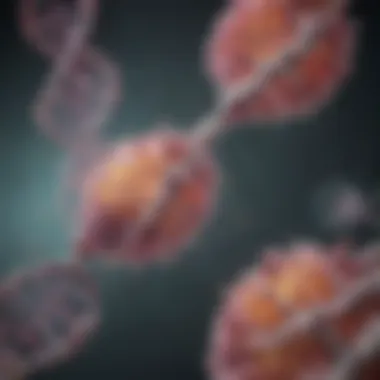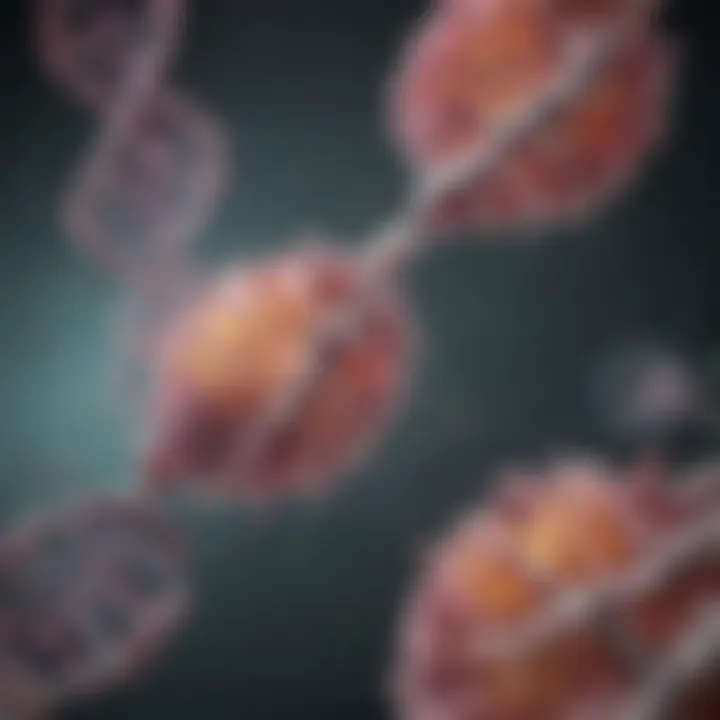Exploring Cancer Epigenetics: Molecular Insights


Intro
Cancer epigenetics represents a crucial intersection between genetics and molecular biology. It focuses on how gene expression can be modified without changes to the underlying DNA sequence. These modifications play intricately key roles in cancer development and progression. In an era where personalized medicine is gaining momentum, understanding these epigenetic changes becomes vital. A comprehensive grasp of this subject not only aids in identifying potential biomarkers but also facilitates the development of novel therapeutic strategies.
As we move forward, this article will delve into various epigenetic mechanisms. We will explore histone modifications, DNA methylation, and the impact of non-coding RNAs. Each of these elements contributes uniquely to the cancer landscape. Furthermore, the narrative will discuss current research methodologies that investigate these processes, bridging the gap between complex scientific research and its practical applications in oncology.
The significance of these studies cannot be understated. By uncovering the workings of cancer at a molecular level, researchers pave the way for innovative treatments. This exploration yields insights that could redefine how we approach cancer therapy, shifting focus towards targeting epigenetic markers.
Recent Advances
Latest Discoveries
Recent studies have uncovered important epigenetic modifications that are pivotal in cancer dynamics. For example, alterations in DNA methylation patterns have been linked to various tumor types. Researchers have identified specific genes that, when hypermethylated, lose their expression, contributing to tumorigenesis. Studies further show that certain histone modifications, such as acetylation and methylation, directly influence chromatin structure and gene accessibility. These findings necessitate a closer examination of how such changes can be reversed or targeted therapeutically.
Technological Innovations
Advancements in technology have greatly enhanced our understanding of cancer epigenetics. Techniques such as CRISPR/Cas9 allow for precise editing of epigenetic marks in the genome. Additionally, high-throughput sequencing technologies enable researchers to map out methylation patterns on a genome-wide scale. These innovations not only foster research but also open avenues for therapeutic interventions. Integrative methods that combine genomics with epigenomics provide deeper insights into how these modifications manifest in cancer.
"A comprehensive grasp of cancer epigenetics aids in identifying potential biomarkers and developing novel therapeutic strategies."
Methodology
Research Design
To study cancer epigenetics effectively, researchers typically employ a variety of study designs. These can include case-control studies to compare methylation patterns between cancerous and non-cancerous tissues. Longitudinal studies are also valuable, enabling the observation of epigenetic changes over time as cancer progresses. The choice of design will depend on the specific question being addressed.
Data Collection Techniques
Data collection in cancer epigenetics often utilizes tissue samples, blood samples, and cell lines.
Some prominent techniques include:
- Methylation-specific PCR: Used to detect specific methylated regions.
- ChIP-Seq: To analyze histone modifications and their impact on gene regulation.
- RNA-Seq: For examining non-coding RNAs and their roles in gene expression regulation.
Using these methods allows for a comprehensive analysis of epigenetic modifications and their correlation with cancer outcomes. The integration of diverse data sets enhances the strength and validity of findings, ensuring that our approach to understanding cancer is robust and relevant.
This compelling exploration of cancer epigenetics sets the stage for ongoing research, underscoring the need to bridge complex scientific discoveries with practical applications in medicine.
Intro to Cancer Epigenetics
Cancer epigenetics is an essential field that explores how gene expression can be modified without changes to the underlying DNA sequence. This aspect is particularly crucial in understanding cancer, as many cancerous behaviors are not solely the result of mutations in the DNA but rather how these genes are regulated. The introduction to this topic sets the stage for a deeper exploration into the interactions between genetic and epigenetic factors within cellular environments.
Epigenetic mechanisms can influence cell behavior, contribute to heterogeneity in tumors, and even provide insights into treatment responses. By studying these mechanisms, researchers and clinicians can uncover potential diagnostic markers and therapeutic targets, making this an invaluable area of study. Understanding cancer epigenetics enables a comprehensive approach towards prevention and treatment strategies, as it connects molecular biology with clinical applications.
Defining Epigenetics
Epigenetics refers to heritable changes in gene function that do not involve changes in the DNA sequence. These modifications can affect how genes are expressed and ultimately influence the phenotype of an organism. Common epigenetic changes include DNA methylation, histone modifications, and the action of non-coding RNAs. Each of these modifications provides a layer of regulation over genetic expression making them vital in processes like development, differentiation, and disease.
In the context of cancer, the epigenetic landscape can be altered, leading to the activation of oncogenes or silencing of tumor suppressor genes. Recognizing the mechanisms at play allows for the identification of potential intervention points, which could lead to new cancer therapies. Thus, defining epigenetics goes beyond academic interest; it leads to practical approaches for battling cancer.
Importance in Cancer Biology
Cancer biology heavily relies on epigenetic insights to deepen our understanding of tumor genomics. The significance of epigenetics in this realm cannot be overstated. Epigenetic modifications may act as a response to environmental factors, lifestyle choices, and even treatment protocols, making them key determinants of cancer risk and progression.
Some key points highlighting the importance of cancer epigenetics include:


- Gene Regulation: Epigenetic changes can lead to aberrant regulation of genes involved in cell cycle control, apoptosis, and genomic stability.
- Tumor Heterogeneity: Tumors can exhibit a variety of epigenetic modifications that reflect their unique environments and histories. This heterogeneity can complicate treatment strategies.
- Biomarker Development: Certain epigenetic alterations can serve as biomarkers for early detection, prognosis, and therapeutic response, enhancing personalized medicine approaches.
In summary, cancer epigenetics provides crucial insights into the molecular underpinnings of cancer. Ultimately, it shapes our understanding not only of cancer progression but also of potential avenues for intervention. The study of epigenetics thus enriches the field of oncology, offering hope for more effective treatments and a better understanding of this complex disease.
"The epigenetic mechanisms unlock a new dimension in understanding the complexity of cancer, bridging the gap between genetics and clinical outcomes."
By forging connections between epigenetics and cancer biology, researchers can build a comprehensive toolkit for tackling cancer on multiple levels.
Mechanisms of Epigenetic Regulation
Understanding the mechanisms of epigenetic regulation is crucial for grasping cancer biology. Epigenetics represents the modifications that control gene expression without changing the DNA sequence itself. These processes play a significant role in how cancer develops and progresses. Anomalies in epigenetic mechanisms can lead to the activation of oncogenes or the silencing of tumor suppressor genes, critically impacting cellular behavior.
By studying these energetic changes, researchers can identify targetable pathways for therapeutic intervention. The following subsections will examine the three primary elements of epigenetic regulation: DNA methylation, histone modifications, and non-coding RNAs. Each component holds unique characteristics that contribute to our understanding of cancer.
DNA Methylation
DNA methylation is a key aspect of epigenetic regulation, which involves the addition of a methyl group to the DNA molecule. This modification typically occurs at cytosine residues in a CpG dinucleotide context.
Role in Gene Silencing
The role of DNA methylation in gene silencing is a foundational concept in epigenetics. When methyl groups attach to specific regions of DNA, they prevent transcription factors from accessing the gene, leading to reduced expression or complete silencing of that gene.
This mechanism is powerful, as it allows cells to modulate gene activity rapidly in response to environmental signals. A prominent characteristic of this silencing effect is its permanence, allowing for stable cellular differentiation. However, while beneficial for normal cellular function, aberrant DNA methylation can contribute to cancer by silencing tumor suppressor genes.
The unique feature of this gene silencing includes the long-lasting impact on gene expression, which can have profound inluences on phenotype. On the downside, excessive silencing can lead to unchecked cell proliferation, as crucial regulatory pathways may be disrupted.
Implications for Tumor Suppression
DNA methylation's implications for tumor suppression are also noteworthy. Hypermethylation of specific genes often correlates with loss of function in vital tumor suppressor genes. This loss can accelerate tumor growth and promote malignancy.
This connection underscores why studying DNA methylation brings meaningful insight into cancer biology. Importantly, targeting methylation patterns could reveal new therapeutic strategies. However, the complexity of methylation landscapes presents challenges. Not all methylation marks are indicative of cancer, making the interpretation of methylation data a daunting task.
Histone Modifications
Histone modifications involve chemical alterations to histone proteins around which DNA is wound. These changes orchestrate a dynamic regulation of gene expression by modifying chromatin structure.
Acetylation and Gene Activation
Acetylation is a histone modification that typically leads to gene activation. The addition of acetyl groups neutralizes the positive charge of histones, resulting in a more relaxed chromatin structure. This allows transcription machinery to access the underlying DNA more efficiently.
This characteristic makes acetylation particularly vital for normal cellular function. Its unique feature is that it can be reversed quickly, allowing for rapid changes in gene expression in response to various stimuli. This flexibility proves advantageous during processes like cell differentiation. However, misregulation can lead to overexpression of oncogenes, further complicating cancer development.
Methylation Patterns in Cancer
Histone methylation is central to epigenetic regulation, influencing gene silencing and activation based on which histones are modified and the context of these modifications. Patterns of histone methylation can be complex, often varying across different cancer types.
The key characteristic of methylation patterns is their ability to signal context-specific gene regulation. This specificity makes it a beneficial choice for understanding cancer heterogeneity. However, these patterns can vary widely within tumor cells. As a result, they can complicate the development of consistent therapeutic strategies.
Non-Coding RNAs
Non-coding RNAs play a significant role in epigenetic regulation, influencing how genes are expressed without being translated into proteins. Their scope of action includes affecting chromatin structure and modulating mRNA stability.
MicroRNAs in Tumorigenesis
MicroRNAs, small non-coding RNAs, are vital in tumorigenesis. They regulate gene expression by binding to complementary sequences in mRNA, leading to gene silencing or degradation. This process can profoundly impact cellular proliferation, survival, and differentiation.


The key feature of microRNAs is their broad regulatory function; they can target multiple mRNAs, influencing numerous pathways simultaneously. This makes them popular candidates for potential biomarkers or therapeutic agents in cancer treatment. However, their complex regulatory networks mean that a single microRNA can have opposing effects in different cellular contexts, complicating their use in targeted therapies.
LncRNAs and Their Functions
Long non-coding RNAs (lncRNAs) represent another critical dimension of epigenetic regulation. These molecules can modulate gene expression by interacting with chromatin, transcription factors, or other RNA molecules, impacting various cellular processes.
The key characteristic of lncRNAs is their potential to serve diverse functions, from transcriptional regulation to chromatin remodeling. This versatility makes them a beneficial focus within cancer research. However, their diverse roles can create ambiguous interpretations depending on the cancer context, leading to challenges in applying lncRNA knowledge in clinical practice.
Epigenetic Alterations in Different Cancer Types
Understanding epigenetic alterations in various cancer types is crucial. These modifications can profoundly affect gene expression without changing the DNA sequence. They play a vital role in tumor development, progression, and response to treatment. By exploring specific cancer types, researchers can identify unique epigenetic patterns and potential biomarkers. This can lead to targeted therapies that improve patient outcomes. The distinct epigenetic landscapes provide insights into the mechanisms of cancer, guiding both research and clinical practices.
Breast Cancer
Breast cancer is one of the most studied cancers regarding epigenetic alterations. Research has shown that DNA methylation changes frequently occur in the breast tissue of patients. Specific genes, such as the BRCA1 gene, often demonstrate hypermethylation, leading to reduced expression and increased cancer risk. Furthermore, aberrant histone modifications contribute to the silencing of tumor suppressor genes. Non-coding RNAs, especially microRNAs, are also implicated in regulating gene expression in breast cancer. These epigenetic factors create a complex network that influences tumor initiation and progression.
Lung Cancer
Lung cancer exhibits distinct epigenetic changes that correlate with its aggressive nature. Studies reveal that the methylation of genes involved in cell cycle regulation often occurs. For instance, the p16INK4a gene is frequently hypermethylated in lung tumors. This silencing effect removes critical checkpoints in cell division, promoting uncontrolled growth. Additionally, histone modifications can lead to the activation of oncogenes, facilitating tumor progression. The role of microRNAs is also significant, as they can modulate the expression of genes associated with metastasis. Understanding these epigenetic alterations can enhance the development of lung cancer-specific therapies.
Colorectal Cancer
Colorectal cancer demonstrates a range of epigenetic changes that are crucial for its pathogenesis. DNA methylation patterns in this cancer type often include the silencing of genes responsible for maintaining genomic stability. The adenomatous polyposis coli gene is a prime example, where methylation leads to its loss of function. Furthermore, abnormal histone modifications can alter chromatin structure, affecting gene expression. Research shows that non-coding RNAs, especially long non-coding RNAs, play roles in driving malignant behavior in colorectal cells. Identifying these epigenetic markers can provide targets for early diagnosis and innovative treatments, ultimately improving patient care.
Clinical Implications of Epigenetic Research
Understanding the clinical implications of epigenetic research is crucial in the fight against cancer. This field offers promising avenues for diagnostics and therapeutics by exploring how epigenetic alterations contribute to tumor development. The ability to identify and measure epigenetic changes can lead to earlier and more accurate diagnosis, as well as provide targeted treatment options tailored to individual patients.
Biomarkers for Diagnosis
Biomarkers play a key role in cancer diagnostics. Epigenetic biomarkers are particularly useful as they can reveal the presence and progression of cancer at a molecular level without requiring invasive procedures. For instance, specific patterns of DNA methylation can indicate certain types of tumors, allowing for a more nuanced diagnosis compared to traditional methods.
Using methylation-specific assays, clinicians can identify changes unique to specific cancer types. This precision enables healthcare providers to develop personalized treatment strategies based on the individual’s unique epigenetic landscape. Moreover, monitoring these biomarkers over time can help assess treatment efficacy and disease progression.
Therapeutic Strategies
The therapeutic landscape in cancer is rapidly evolving, and epigenetics is at the forefront of this change. Targeting epigenetic modifications holds the potential to reverse aberrant gene expression that leads to tumorigenesis. Two notable classes of drugs that have emerged are DNA methyltransferase inhibitors and histone deacetylase inhibitors.
DNA Methyltransferase Inhibitors
DNA methyltransferase inhibitors are a class of drugs that inhibit the enzymes responsible for adding methyl groups to DNA. By doing so, these inhibitors can reactivate silenced tumor suppressor genes, thereby restoring their function and reducing tumor growth.
The key characteristic of these drugs is their ability to target abnormal methylation patterns prevalent in various cancers, allowing for a more tailored approach to treatment. A popular example is Azacitidine, used in treating myelodysplastic syndromes. Its unique feature is that it can lead to both immediate and long-lasting changes in gene expression, making it a beneficial choice in clinical settings. However, one disadvantage is that these inhibitors can sometimes cause off-target effects, prompting a need for careful patient monitoring.
Histone Deacetylase Inhibitors
Histone deacetylase inhibitors also play a significant role in cancer therapy. These drugs work by preventing the removal of acetyl groups from histone tails, leading to a more relaxed chromatin structure. Such changes increase the transcription of certain genes that may be repressed in cancer cells.
A well-known agent in this category is Vorinostat, which is used to treat cutaneous T-cell lymphoma. Its key characteristic is that it not only influences cancer cell growth but also modulates the tumor microenvironment, potentially enhancing immune response against the tumor. However, the challenges associated with histone deacetylase inhibitors include dose-limiting toxicities and variable responses across different cancer types.
"Epigenetic therapies have the potential to revolutionize cancer treatment, shifting the focus from merely targeting the tumor to also addressing the underlying biological mechanisms contributing to its growth."
Thus, the exploration of epigenetic strategies in cancer care highlights a shift toward personalized medicine, enhancing diagnosis and treatment for patients.
Research Methodologies in Cancer Epigenetics


Research methodologies in cancer epigenetics are crucial for advancing our understanding of how epigenetic modifications affect gene expression in cancer. These techniques enable scientists to examine the intricate mechanisms that underlie the relationship between epigenetics and cancer biology. Robust methodologies are needed to validate findings, derive insights, and translate discoveries to clinical applications. From high-throughput sequencing techniques to specialized chromatin analysis, these methodologies provide a foundation for innovative research that drives the field forward.
Next-Generation Sequencing
Next-Generation Sequencing (NGS) has revolutionized the landscape of genomic research, including cancer epigenetics. NGS technologies allow for rapid and cost-effective sequencing of entire genomes, making it possible to uncover epigenetic modifications at a high resolution. Essential steps include:
- Data Generation: NGS generates massive amounts of data, which includes information about DNA methylation and histone modifications. This vast dataset is vital for identifying global epigenetic changes in various cancer types.
- Data Analysis: Advanced bioinformatics algorithms interpret the NGS data. This analysis helps to pinpoint significant epigenetic changes that correlate with tumor progression or patient prognosis.
- Comparative Studies: NGS facilitates comparisons between normal and cancerous tissues. Thus, researchers can identify specific epigenetic alterations that drive tumorigenesis.
The application of NGS in cancer epigenetics is significant because it provides a comprehensive view of the epigenome, allowing for a better understanding of complex interactions between genetic and environmental factors.
ChIP-Seq Analysis
Chromatin Immunoprecipitation Sequencing (ChIP-Seq) is another powerful tool in cancer epigenetics research. This technique combines chromatin immunoprecipitation with NGS to analyze protein-DNA interactions and histone modifications. Key components of ChIP-Seq include:
- Target Protein Selection: Researchers first select specific proteins, such as transcription factors or histone modifications, relevant to cancer development. This selection helps focus the study on significant pathways.
- Chromatin Preparation: The target proteins are crosslinked to DNA in the cells. The chromatin is then sheared into smaller fragments, which is essential for efficient analysis.
- Immunoprecipitation: Specific antibodies are used to pull down the protein of interest along with the bound DNA sequences. This step enriches the sample for sequencing.
- Data Interpretation: The sequenced data reveals binding patterns and modifications associated with gene regulation during cancer progression. This information can help clarify the role of different regulatory elements in oncogenesis.
ChIP-Seq plays a vital role in elucidating how epigenetic changes influence gene expression in cancer cells, aiding the development of targeted therapeutic strategies.
"Research methodologies in cancer epigenetics are the bedrock upon which we build our understanding of this complex field. Without rigorous analysis, the potential to translate findings into clinical practice diminishes."
Challenges and Future Directions
In the field of cancer epigenetics, significant challenges persist that hinder the advancement of research and application. These challenges are crucial as they inform the path forward, shaping future investigations and potential therapeutic strategies. The complexities of epigenetic regulation provide an intricate landscape that demands nuanced understanding and interdisciplinary approaches.
Understanding Complexity in Epigenetic Regulation
Epigenetic regulation is inherently complex, characterized by multiple layers of gene expression control. Unlike genetic alterations that lead to changes in the DNA sequence, epigenetic modifications can shift dynamically in response to internal and external stimuli. This fluidity complicates the establishment of direct cause-and-effect relationships between epigenetic changes and cancer progression.
Key elements contributing to this complexity include:
- Multifactorial Influences: Environmental factors, such as diet and exposure to toxins, can induce epigenetic changes, making it challenging to pinpoint specific causative elements for tumor development.
- Interconnected Pathways: Epigenetic mechanisms do not operate in isolation. DNA methylation and histone modifications interplay with other molecular pathways, creating a web of interactions that can obscure the pathways relevant in different cancer types.
- Variability Among Individuals: Genetic background and epigenetic diversity among patients can affect the response to epigenetic therapies. This variability must be accounted for to develop personalized treatment strategies.
Addressing these complexities requires sophisticated research methodologies that can elucidate the nuanced roles of epigenetic modifications in cancer. Advanced technologies, such as single-cell epigenomics, promise to unveil the heterogeneity within tumors, which is critical for understanding the unique epigenetic landscape of each cancer type.
Translating Research into Clinical Practice
The translation of epigenetic research into clinical practice remains a pressing challenge faced by researchers and clinicians. While the potential for epigenetic therapies in oncology is promising, several barriers impede their implementation in routine clinical care. Some of these barriers include:
- Regulatory Hurdles: The approval process for new therapies can be lengthy and complex. Regulatory bodies must evaluate the safety and efficacy of epigenetic drugs, which may differ from traditional therapies that target genetic mutations.
- Clinical Trial Design: Designing trials that assess epigenetic therapies presents unique challenges. The choice of biomarkers for patient stratification, optimal treatment regimens, and endpoints must be carefully considered to ensure that the trials yield informative results.
- Integration into Current Practices: There is a need for effective communication between researchers and clinicians to seamlessly integrate epigenetic findings into treatment protocols. This collaboration will enhance understanding among healthcare professionals about the implications of epigenetic changes in cancer diagnosis and therapy.
The divergence between laboratory research and clinical application highlights a critical gap that must be bridged for the successful integration of epigenetic approaches in oncology.
Future directions in cancer epigenetics should focus on overcoming these challenges. Continued investment in technology and interdisciplinary research will be vital in delineating the complexities of epigenetic regulation.
Finale
The topic of cancer epigenetics is crucial in understanding the mechanisms that lead to the development and progression of cancer. Epigenetic modifications do not involve changes to the underlying DNA sequence, yet they play a significant role in regulating gene expression. These modifications influence tumorigenesis and can dictate the behavior of cancer cells.
Summary of Key Points
This article presented several essential aspects of cancer epigenetics:
- Mechanisms of Regulation: We explored DNA methylation, histone modifications, and the roles of non-coding RNAs, highlighting how each mechanism contributes to the complex landscape of cancer biology.
- Cancer Types: Specific examples such as breast cancer, lung cancer, and colorectal cancer illustrated how epigenetic alterations vary across different malignancies, affecting diagnosis and treatment options.
- Clinical Implications: The potential for epigenetic strategies in diagnosis and therapy outlines a promising frontier in oncology. Techniques such as DNA methyltransferase inhibitors and histone deacetylase inhibitors represent transformative approaches to treatment.
- Research Methodologies: Methods like next-generation sequencing and ChIP-Seq analysis provide tools to decipher the intricate epigenetic modifications present in various cancers.
- Future Challenges: Understanding the complexity of epigenetic regulation and translating research into clinical practice are both challenging yet essential for advancing cancer treatment.
Final Thoughts on the Future of Cancer Epigenetics
Looking ahead, the field of cancer epigenetics stands at a pivotal point. Continuing to unravel the intricate networks of epigenetic regulation will likely lead to breakthroughs in targeted therapies and personalized medicine. Researchers must focus on translating epigenetic findings into clinical applications effectively.
Addressing the challenges around complexity in epigenetic analysis will enable better integration of findings into routine clinical practices. The potential to identify biomarkers for early diagnosis and tailor treatments based on epigenetic profiles offers a hopeful perspective for the future. With ongoing advancements and collaborative efforts, the promise of epigenetics in reshaping cancer treatment appears bright.
"Epigenetics is the key to understanding not just the 'what' but the 'how' of cancer development. By focusing on these mechanisms, we can pave the way for innovative therapies and comprehensive cancer care."
Embracing this evolution in understanding cancer biology will ultimately contribute to more effective, safer, and precise treatments for patients.















